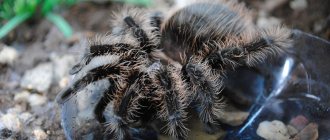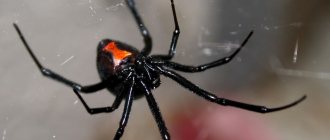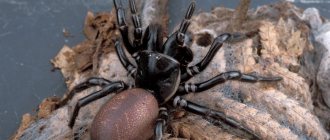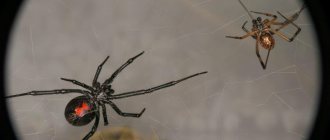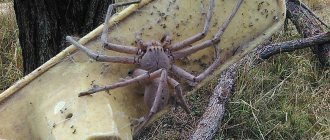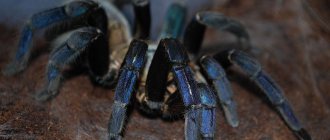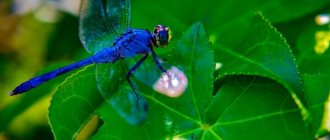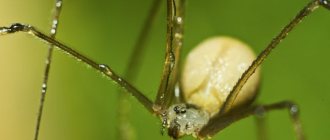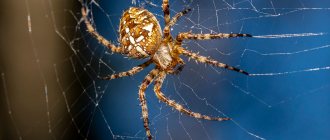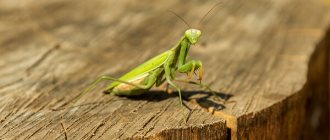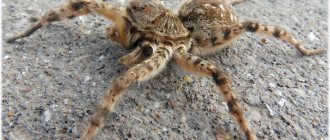- Wild animals
- >>
- Arachnids
The prevalence of sexual cannibalism, in which the female eats the male after mating, influenced the species' common name, black widow . This species is considered to be one of the most poisonous. The venom of a female spider exceeds the toxicity of toxic substances in a rattlesnake. However, only a female bite is dangerous to humans. The bites of male and teenage spiders are harmless.
Does the black widow live in Russia?
In Russia, spiders from the genus Latrodectus live in warm regions, for example in the steppes of Kalmykia, the Astrakhan region, as well as in the Black Sea and Azov regions.
There were cases of bites in the Orenburg, Kurgan and Saratov regions. This summer (2019), many news headlines were full of reports of attacks by black widows in the Moscow region, and even cases of bites were recorded, but without deaths.
Since spiders can travel using their web as a sail and thus move over long distances, this explains their appearance in the Moscow region.
Here you need to understand that most likely one of the varieties of the black widow Latrodectus tredecimguttatus ended up in the Moscow region, and not the deadly spider Latrodectus mactans.
Latrodectus tredecimguttatus is the European black widow, or our usual name karakurt. This is also a dangerous spider, it has external similarities with the species Latrodectus mactans, but is still less toxic.
Karakurt (Latrodectus tredecimguttatus)The poison contains a lethal dose of dangerous neurotoxin LD 50
- Latrodectus tredecimguttatus - 0.59 mg/kg;
- Latrodectus mactans - 0.90 mg/kg.
That is, in terms of the toxicity of the poison, the Russian spider is almost two times less poisonous compared to the “real” Black Widow.
Karakurt (Latrodectus tredecimguttatus)
It is regularly found in Crimea, and very rarely it can even be found in the Moscow region.
The habitat of the “real” deadly black widow Latrodectus mactans is the hot regions of the United States.
The genus of spiders of the Black Widow family (Latrodectus) has more than 31 species, and among them there are spiders very similar to the real black widow, most of them are less toxic compared to the species Latrodectus mactans.
We recommend: How to catch crayfish and how to keep them alive
Origin of the species and description
Photo: Black Widow
The black widow genus was classified by Charles Athanas Walkenaer in 1805. Arachnologist Herbert Walter Lewy revised the genus in 1959, studying the female genitalia and noting their similarities between described species. He concluded that color variations were variable throughout the world and were not sufficient to warrant species status, and reclassified the red and several other species as a subspecies of the black widow spider.
Video: Black widow spider
Levy also noted that the study of the genus had been extremely controversial before this, as in 1902 F. Pickard-Cambridge and Friedrich Dahl revised the genus, each criticizing the other. Cambridge questioned the division of the Dahlem species. He considered the deviations that his opponent drew attention to as minor anatomical details.
This is interesting! In the 1600s, people in southern Europe danced and raved after being bitten by a variant of the Black Widow. The movements were said to relieve painful symptoms. Their rhythmic movements were later called the tarantella dance, after the Italian region of Taranto.
Many people don't like spiders. Some believe they bring bad luck; others, on the contrary, believe that they bring good luck. Black widows have been useful in controlling pests such as fire ants and termites. Previously, doctors often made the wrong diagnosis after a spider bite. Mistaking the severe condition of the chest and abdomen for symptoms of a perforated appendix.
Black Widow Identification
The size and appearance of male and female spiders differ from each other. The female is larger, its size, excluding legs, ranges from 8 to 13 mm, and its weight averages about 1 gram.
Black widow, Latrodectus mactans, distinguished from other species by a red spot on the abdomen in the shape of an hourglass
An adult female has a more rounded and voluminous body compared to the male. The color is glossy black, with a red, hourglass-shaped spot on the belly that serves to warn off predators. Sometimes there may be a stripe consisting of irregular red spots appearing on the upper body.
The male's body is smaller, with the exception of the legs, measuring from 3 to 6 millimeters. The body is elongated, on the side of the abdomen there are 4 pairs of white and red stripes. Young males are mostly white, orange and brown. They become darker in color as they mature.
Spiders are arthropods. Protection of the body from small predators is provided, like all spiders, by a shell that constantly changes during the molting process. During molting, the spider is more vulnerable.
The spider has 8 eyes, which are arranged in two horizontal rows of 4. The pair of eyes in the center of the bottom row is considered primary, and the rest are considered secondary.
Social structure and reproduction
Photo: Black Widow
Black widows usually mate in the spring and summer. The female produces an egg mass containing about 200+ eggs. She covers the eggs with cobwebs, then forms a pouch from this, which should protect the eggs from external influences. The sac is suspended from a web to keep it away from predators.
It takes about two weeks for the eggs to hatch. Very few young spiders survive because they eat each other as soon as they are born. Spiderlings molt several times before reaching maturity. Diet and temperature are factors that influence the development of the offspring.
Remember! Females take 2 to 4 months to mature and their lifespan is about 1.1/2 years. Males mature in 2-4 months and live for about 4 months. They lose their outer covering (exoskeleton) as they grow.
Sexual contacts between mating spiders last longer if the male allows himself to be cannibalized. By sacrificing his life, he can fill his partner with more sperm. The female stores these sperm in two storage organs and can control when she uses these stored cells to fertilize her eggs.
If she has sexual intercourse again, the sperm of the second male may displace the sperm of the first. But females who eat their first mate are more likely to reject a subsequent one.
Black Widow's Habitat
Although Latrodectus mactans is a very dangerous spider, it is a timid, shy, solitary and non-aggressive spider. It builds its lair in quiet places, making it difficult to find and detect. It is a nocturnal animal and spends most of its time during the day in a shelter or protected area.
Spiders of this species live in various secluded places.
Like all spiders, the widow spider is a carnivore, feeding on insects, but can attack and eat another spider, including those from its own genus. He traps his prey with a web and immobilizes him with the poison he injects, along with digestive enzymes. It can easily catch and kill even a bird or small animal.
The predator that preys on the black widow is California wasps in the United States. Scientific name Chalybion californicum.
We recommend: Banana spiders - who they are and why they are dangerous
Life cycle
Black widows are solitary all year round except during mating season. Young adults overwinter in buildings or in quiet outdoor areas. At the end of spring, after a long courtship, mating occurs. In some cases, the female kills her mate and begins laying eggs.
Eggs
A grayish silk ball of eggs with a funnel-shaped exit is attached to the web. Each female builds from 5 to 15 such balls, 12-15 mm in diameter, each of which contains from 200 to 900 eggs. These clutches are fiercely guarded by the mother until spiders emerge from them.
Spiders (babies)
Young spiders emerge from the ball after 10-30 days. Only a handful of them will survive, as black widows are cannibals in the early stages of their lives. They consume other spiders from their brood for nutrients.
Older individuals die in the summer or autumn after laying eggs. New generation survives through winter
The surviving spiderlings undergo molting. At first they are white, then orange, and only after a couple of months they resemble adult male black widows. Surviving individuals leave the network. It will take 2-3 months for them to mature, begin to weave their cloths and get food.
Older individuals die in the summer or autumn after laying eggs. The new generation survives through the winter.
Interesting! Although the life expectancy of black widow spiders is one year, some females live up to three years. Males are usually only 1-2 months old. These spiders live longer in captivity.
Experts categorically do not recommend keeping a black widow at home or breeding it for non-professionals
Black Widow bite and venom
As we wrote above, this spider is shy and timid, so it can bite only in self-defense or fright. When it bites, it injects only a small dose of venom, which can rarely kill a healthy person.
Those at risk of death from its bite are children, the elderly, or those with weakened immune systems.
In all cases, it is important to begin treatment immediately after the bite, since it is not known how the toxins from the poison will behave in the body.
A spider bite is practically painless and can go unnoticed right away, for this reason it is difficult to understand why the person felt ill.
Black widow venom contains the neurotoxin alpha-latrotoxin, as well as adenosine, guanosine and inosine. These substances cause muscle contractions, headaches, nausea, dizziness and severe abdominal pain. Sweating and difficulty breathing may occur.
The poison is strong, its lethal dose LD50 is 0.90 mg/kg.
Features of character and lifestyle
Photo: Black widow spider
The black widow spider is nocturnal. She hides in dark and untouched places, in small recesses created by animals, under fallen branches, piles of trees and rocks. Sometimes they live in rodent burrows and hollow stumps. Other habitats include garages, outbuildings, and sheds. Nests inside homes are found in dark, undisturbed places such as tables, furniture, and the basement.
Sexual cannibalism in the female actually increases the chances of survival of the offspring. However, females of some species rarely exhibit this behavior. Much of the documented evidence of sexual cannibalism occurs in laboratory cages where males cannot escape.
This is interesting! Male black widow spiders choose their mates by determining whether the female is currently full to avoid being eaten. They can tell if a spider has eaten by looking at sensitive chemicals in the web.
The widow is not aggressive, but can bite when her calm is disturbed. If caught in a trap, it is unlikely to bite, preferring to play dead or hide. Bites are possible when the spider is cornered and cannot escape. Injuries to humans occur due to defensive bites caused when a female is unintentionally crushed or pinched.
Need to know! Black widow venom is poisonous. When the fangs enter the skin, they remain there for a few seconds. Venom glands contract to deliver venom through ducts in the fangs.
The syndrome resulting from the bite is known as "latrodectism." Painful symptoms are felt throughout the body. Black widow venom is called "neurotoxic" because it affects the nerves. When the nerve endings do not work: the muscles cease to obey, the body becomes rigid, paralysis and convulsions intensify. Sometimes the breathing muscles stop working, causing suffocation.
Latrodectus mactans bite
Fortunately for humans and other animals, black widows are able to control the amount of poison injected into the victim. Depending on the situation, they may inject their venom, but in most cases this is not the case. The production of venom for a spider requires a lot of energy, and it does not need to bypass the venom in order to feed, so it tries not to waste it again.
The spider uses its bite in two cases: attack and defense. When attacking or defending offspring, the black widow injects a small amount of venom proportional to the size of the victim.
During defense, the spider bites only when it is necessary; it prefers to retreat and escape. Typically, when a black widow bites a person, the bites contain no or minimal venom.
Almost all bites of this spider occur due to the fact that a person stepped on it, or stuck their hand where it lives.
It happens that during the night a spider can build its shelter in a person’s shoes, so putting on shoes in the morning can easily get a bite. Therefore, if you are in the southern United States and if you left your shoes outside overnight, check in the morning that no one has settled in them.
We recommend: How to catch crayfish and how to keep them alive
Keeping at home
Some originals have all kinds of exotic animals at home and even try to breed them. Spiders were also among the chosen ones. In principle, keeping and feeding them is not difficult, there is a lot of information on the Internet, but getting offspring is already a problem.
As for the black widow, one of the most dangerous spiders in the world, experts categorically do not recommend keeping it at home or breeding it for non-professionals.
Chasing the exotic, you forget about the basic instinct of self-preservation. The result can be disastrous, because despite the shyness, 5% of attacks of such a pet end fatally.
The black widow produces a dirty, dense web. Her canvases are usually located near ground level and under protected overhangs, such as under furniture or a wooden porch on stilts. Red hourglass markings will also indicate the presence of this species
How to recognize a Black Widow bite
This spider injects its venom into its prey using its two front fangs, so close inspection reveals two tiny holes. Symptoms of a black widow bite: acute pain at the site of the bite, severe burning and numbness of the affected area.
Depending on the amount of venom injected, the person's age, health, and location of the bite, symptoms may vary. Common symptoms include headache, restlessness, weakness, possible nausea and vomiting, dizziness and sweating.
If you are bitten by Latrodectus mactans, the first thing you need to do is go to an ambulance or go to the hospital yourself. While you are waiting for help, you need to apply ice or something cold to the bitten area, this will reduce pain and swelling. If possible, take with you the spider that bit you; if it is dead, if it is alive, it is better not to catch it.
Antidote for Black Widow
To treat a bite, doctors use droppers with calcium gluconate and muscle relaxants; this is sufficient in most cases.
In serious cases, when there is a risk of death and it is not possible to transport the victim to the hospital, a special serum is used. But the use of serum is quite risky for the victim; it is practically not used for children under 16 years of age. Administration of the serum is possible only by a doctor and under his supervision, as urgent resuscitation may be required due to its allergic effect.
If you are bitten by a poisonous spider, always try to pick it up and put it in a jar. It will be easier for doctors to cure you, and treatment will be faster.
Precautionary measures
During the period of spider migration, prevention is especially necessary to prevent the possibility of bites. It is not recommended to walk barefoot. When going to bed in nature, you need to tuck your shirt well into your trousers, thus limiting the karakurt from getting on your naked body, where you can go unnoticed and crush it, resulting in a bite. If karakurt has penetrated the body, you must try to seize the opportune moment and remove it from there, disturbing it as little as possible.
Scientists note that karakurts avoid meeting people. If the spider is not disturbed, then it tends to quickly leave the area where it was found and hide in a secluded place. Gauze nets reliably protect against spiders. Having carefully tucked the edges of the gauze under the bed, you can use these nets for overnight stays. Considering that spiders hide among crevices and cracks in the soil, a place to spend the night should be chosen on a flat surface, removing small stones.
Black Widow Reproduction
Reproduction of a black widow is the same as that of all spiders, so we will not repeat it, in short it is courtship and sexual contact with the help of its legs. After mating, the female lays eggs; the incubation period lasts approximately 20 days.
Cocoon with black widow eggs, photo ru.wikipedia.org
During the mating stage, the female can kill the male. This feature is where its name, Black Widow, comes from. True, many species of spiders do the same.
First aid for a karakurt bite
To act effectively, you need to know what karakurt looks like - then you can take some measures immediately. Large females bite; small males usually cannot bite through the skin at all, and if they suddenly bite through, they also have several times less poison.
But even in females, the chelicerae (mouth parts) are short and penetrate the skin by only 0.5 mm. Therefore, if you are sure that it was the karakurt that bit (you were able to see the offender), you should immediately cauterize the bitten area (with a match head or a hot knife tip). This must be done within 2 minutes - then almost all the poison can be neutralized, and the poisoning will be completely mild. It hurts, but the consequences of the bite are much more painful. And you still need to run to the doctor.
Doctors have a special anti-karakurt serum. There are other effective treatment methods, so with sufficient promptness the prognosis will be very good. But in many cases, treatment can take several days, or even weeks.
On topic: South Russian tarantula and Crimean scorpion
“I was very lucky”
James Kerrigan James Kerrigan, another shark victim, this time from the Hawaiian Islands, unlike the German woman, felt almost nothing when bitten. He told Hawaii News Now over the phone:
“She bit me really quickly and patted me on the leg a little bit. At first I thought it was one of my friends swimming up from behind and shaking me to scare me, but then I saw blood, and my only thought was: “Oh God, I need to get to the shore.”
James Kerrigan According to Kerrigan, things could have ended much worse:
“There were several deep wounds, but the predator’s teeth did not touch the bones and large vessels, so the doctors only had to stitch together the torn muscles.” James Kerrigan
African hippopotamus
In May of this year, The Guardian daily published the story of a man who was almost bitten in half by one of the most dangerous inhabitants of the African Zambezi River - a hippopotamus. Here are some excerpts from this story, in the spirit of Henry Rider Haggard's African adventure novels: “I remember looking through three meters of water at the play of yellow and green light and wondering if I could hold my breath longer than a hippopotamus. Then the water turned red with my blood, and I resigned myself to the inevitable...
I don’t know how much time passed while the hippopotamus was chewing me, but these moments seemed like an eternity to me. Apparently he didn’t like me, because after a while I felt like I was on the surface, and then my partner Mike picked me up and brought me to shore. I was in a terrible state: my left arm was almost crushed, and there was a huge hole in my back through which my lungs were visible.”
Fortunately, the traveler was able to provide all the necessary assistance in time, so he is probably one of the few who got out of the hippopotamus’ mouth alive.
Brooke O'Neil and the Rattlesnake
A young family from San Diego was taking their usual Saturday evening walk. Brooke O'Neill, along with her husband and 2-month-old daughter, were admiring the setting sun when a rattlesnake rose from under the stroller with the baby, which had dozed off due to the heat and did not hear the approach of people. Brooke felt a light, not too painful bite on her leg and, screaming, pushed the stroller away, after which her husband heard the characteristic sound of a reptile rattling and hurried to call the doctors.
As O'Neill later said: First I felt my fingers go numb, then it spread to my arms and legs, and later it reached my face. After about ten minutes, I was completely paralyzed—conscious, but unable to move.
Be careful swimming in the Amazon
There are many bloodthirsty predators and poisonous creatures in this river and on its coast. If you ever have to travel through the Amazon, for example by boat, watch your fingers and toes - the river is inhabited by black piranhas that can instantly snatch off two or three phalanges with razor-sharp teeth. Piranhas have jaws that are developed disproportionately to their small body: their bite is about 30 times stronger than that of fish of similar size and weight, and the muscles of piranhas relative to body weight are greater than, for example, a tyrannosaurus rex or a megalodon, the prehistoric ancestor of the great white shark.
Habitat of karakurt
Now let's look at where the black widow lives. This species prefers a moderately warm climate. Comfortable for it are areas with hot summers and warm autumns. It is widespread in Latin America, Africa, Central Asia, southern Europe and northern Africa.
The main habitats of the black widow in Ukraine and Russia: Donetsk and Rostov regions, as well as coastal areas of the Azov and Black Seas. The spider is found in Kazakhstan, Kyrgyzstan, Kalmykia, and Astrakhan.
The spider can also be found in areas with colder climates, but by winter it usually migrates to warmer climates.
Most often, the spider chooses for housing:
- hills, rocky slopes of ravines;
- wastelands, steppes;
- abandoned human habitations.
To hide, the spider prefers abandoned holes and mounds of dry leaves.
The black widow can crawl into human homes for the winter. You can stumble upon it in garages, sheds, outdoor toilets, and old abandoned houses.
To avoid being bitten, when walking in areas where this species is common, you should wear closed, tight clothing. The spider's fangs will not be able to bite through. It is better to work in the garden with gloves.
Size doesn't matter
The ants that inhabit the forests of Nicaragua and Paraguay are famous for the most painful bites in the world. The insects are also known as “bullet ants” because victims report that the pain of the bite is comparable to that of a gunshot wound. In addition, when a person is bitten, there is vomiting, convulsions and dizziness. Some time after the bite, the victim loses consciousness, a fever sets in, and the bite site goes numb.
For a person weighing about 50 kg, as a rule, 60 bites are enough for death to occur - there are animals in nature with much stronger poison, but the bites of these ants are among the most painful. Improvement occurs 4–5 hours after the attack, but in some cases the pain can continue for a whole day.
By the way, local tribes use the powerful jaws of these insects for unique surgical operations: the ants, with their bites, tighten the edges of small cuts, and then the natives tear off their bodies, leaving the head with clenched jaws in place and thus applying “sutures.”

